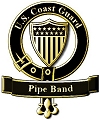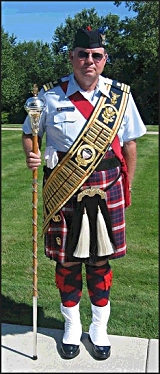 The U.S. Coast Guard Tartan History
The U.S. Coast Guard Tartan History

The design of the United States Coast Guard Tartan was inspired by the family Tartan of Alexander Hamilton, the founder of the Revenue-Marine, and the 'father' of the modern day U.S. Coast Guard. Each color of the Tartan signifies the following:
Red: Symbolizes the courage and sacrifice of the men and women of the Coast Guard and its predecessor services, and their families, in war and peace for more than 200 years.
White: There are 10 threads of white representative of the original 10 Revenue Cutters commissioned by Secretary of the Treasury, Alexander Hamilton in 1790. They were: the Massachusetts, Scammel, Active, Eagle, Diligence, Argus, Vigilant, Virginia, South Carolina and General Greene.
Blue: Symbolizes the seas and skies plied by cutters and aircraft of the Coast Guard as they carry out their missions to serve and protect.
The idea of a Tartan for the Coast Guard actually began in 1997 when JoAnne Pendleton and her Husband, CWO Mike Pendleton, saw the West Point Pipe Band playing at a Scottish festival in New Hampshire. CWO Pendleton remarked, 'Wouldn't it be great if the Coast Guard had a Tartan? I'd love that.' JoAnne decided then and there that she would take on the project and the USCG Kilt would be Mike's retirement gift in 1998.
While researching as to whether such a Tartan existed, Joanne called the Academy and someone at one of the offices begged her to proceed with the project as pipers at the Academy simply wore whatever kilt they could find. Further research showed that no Tartan existed for the U.S. Coast Guard.
In April 1999, Joanne went to Admiral James Loy, Commandant of the Coast Guard, with the idea. He strongly endorsed it and thus began the journey to making this idea a reality.
Such an undertaking could not be accomplished by one person; many people contributed. One of the largest contributors in making the Coast Guard Tartan become a reality was Andrew Anderson, CDR, USCG (Ret). On May 1, 2002, then-Commandant of the Coast Guard, Admiral James Loy, approved the U.S. Coast Guard Tartan.This set the wheels in motion. Material was ordered from Scottish woolen mills and Kilts were made. Alexis Malcolm was the Kilt Maker commissioned to make the first Coast Guard Kilts.
It is important to understand that one does not have to be Scottish to wear the Tartan, but you do have to be Active, Reserve, Auxiliary, Retired or an immediate family member of the foregoing to make up our Coast Guard family. Each individual contributes to the Coast Guard Family and each member represents a thread ... we do not stand alone. This is what makes our Coast Guard family so special.
This young country, being as diverse as it is, learned early that so many nations have much to offer. We adopt ideas and traditions from many countries. The use of a Tartan, recognizing a school, organization or branch of the military in the U.S. has become commonplace. Now, the U.S. Coast Guard has its own; to be used the way it was hundreds of years ago in Scotland as a way to identify one as a member in the Coast Guard 'Clan.'
 |
U.S. Coast Guard Pipe Band, Inc.
290 NW Peacock Blvd #881316
Port Saint Lucie , Florida 34988


